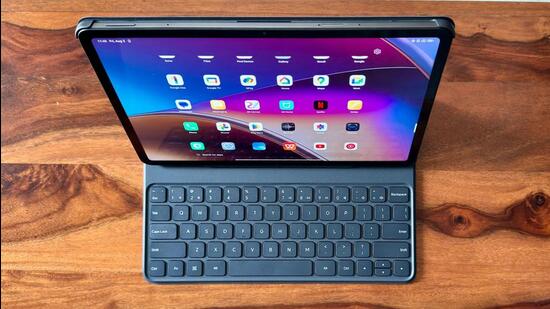Have we reached the crossover point? Can Android tablets become genuine productivity focused computing devices, perhaps even occasional alternatives to your laptop or desktop? Still debatable and subjective, but even then, the signs are positive. Even more so, when the comparatively more affordable Android tabs have shades of finesse, that more expensive tabs usually exhibit. In the case of the Redmi Pad Pro 5G, it there is clear inspiration from the more expensive Xiaomi Pad 6, particularly with the software, to keep things streamlined.
A cursory glance at the competition landscape, and Redmi Pad Pro 5G’s superiority over most of its rivals, becomes quite clear. Again, representative of the dynamism that’s coming through with Android tabs. With prices starting around ₹21,999 (do not forget to check on oft available payment offers), Redmi Pad Pro has not only a larger and better display, but a more powerful chip for multitasking, than a Samsung Galaxy Tab A9+.
The OnePlus Pad Go runs it close, but the Redmi Pad Pro notches an advantage for itself with a slightly more versatile display and larger battery capacity which shows its true stamina form too. The Honor Pad 9, despite stable performance for most workflows, loses out in longevity with a comparatively less powerful chip. Not everyone will appreciate the Lenovo Tab Plus’s industrial design.
On point with the trends defining Android tabs off late, the Redmi Pad Pro 5G has a large display real estate – a 12.1-inch IPS (or in-plane switching) display that’s ticking off 120Hz refresh rate and Dolby Vision on the checklist. Both of these are still quite rare for mid-range Android tablets. This makes it the largest display on a Redmi tab till now, considerably more versatile than the 10.61-incher on the previous Redmi Pad and 11-inches on the Redmi Pad SE. It is easy to appreciate how bright the Redmi Pad Pro 5G’s screen can get, particularly in a brightly lit office environment.
Pro, for a reason. And that is the optional Redmi Keyboard, which can help see through any potential of this larger screen, as a computing device at the workplace. This is priced at ₹3,999 (as is the Redmi Smart Pen, if you’d want a stylus too), which I must note is very sensibly priced. This accessory is designed in such a way, that instead of magnetic attraction, there are more secure physical clamps to keep the tablet secure, when docked. There is no touchpad in Xiaomi’s layout (and you must transition between the physical keys and the touchscreen often), but the keyboard ergonomics are spot on – key spacing, travel and responsiveness.
The Redmi Pad Pro 5G’s use of Qualcomm’s Snapdragon 7s Gen 2 chip gives it a definite advantage over most immediate competition, including the Honor Pad 9 that instead has a Snapdragon 6 Gen 1. I’d say real world performance is at par with the Mediatek Helio G99 in the OnePlus Pad Go, but that can often struggle when bursts of speed are needed. Split screen and floating windows, necessary to fully utilise a large screen potential, is an indicator of HyperOS’ optimisations, including for this chip.
At this point, I must note that if you are using a Xiaomi smartphone too, the ability to have it connect to the Redmi Pad Pro 5G using a feature called the Home Screen+ (the key is, the phone and tablet should be linked with the same Xiaomi account) is incredibly convenient. Monitor incoming notifications on your phone, or transfer files or media from the phone to the tablet (and vice-versa) is seamless to the point you’d probably find difficult to imagine at the outset.
The 10,000mAh battery is larger than the capacities the Redmi Pad Pro 5G’s competition brings to the table, and alongside chip as well as software optimisations, I can testify to a 100% to 30% drop in charge after 18 hours of varied screen time (at auto-brightness). You could possibly do a day’s travel with this as your work machine, without needing to charge at any point in that journey.
All things considered, it is clear the Redmi Pad Pro 5G could have come through with a Xiaomi Pad 6 “Lite” branding, and it’d have absolutely been on point. There is a lot of futureproofing, which adds value to the money you’d spend today on a Redmi Pad Pro 5G. It simply is always a step ahead of its competition. The software in particular, which is able to take advantage of the hardware. As well as by keeping cellular connectivity as a constant, adding to versatility that many may not realise initially (once you get used to 5G on a tablet, it is difficult to go back to a Wi-Fi only machine). All of this collectively, for Android tablets in search of that productivity magic, is priceless.
